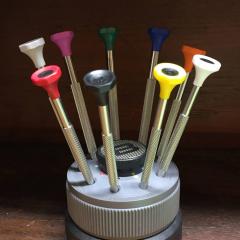Disassembly of ratchet wheel secured with washer
-
Recently Browsing
- No registered users viewing this page.
-
Topics
-
Posts
-
I bought this box of jewels a few years ago and noticed that the glass containers are divided into two sections. In the first section, the containers have a label with red text colour and always start with the letter B. In the second section, the text on the label is black and lacks the letter B. There seem to be roughly the same number of containers in both sections, and each section has the same sizes of jewels. The only difference is that the jewels in the B section with red text have a slightly rounded, convex underside. My question is what are these rounded jewels for and if I can use them instead of the jewels with a flat bottom if a certain size is missing?
-
Yes, as watch repairers we never ever use force, we use percussive persuasion! 🤣
-
I have a barrel bridge arbor bearing that needs a slight reduction. I have never closed a barrel bridge arbor hole before and my staking set has a very limited number of doomed punches and most of them are too small (go through the hole) or too short to fit in the lower section of my inverto-style Boley & Leinen staking tool. So, I'm considering ordering a few doomed punches from CousinsUK. My question is what sizes I should order? Is there a rule of thumb relating to the hole diameter? I too worried that reducing the hole size would increase the end-shake. Especially as Kalle Slaap talks about end-shake at the end of the video at 7:43, but then he just glosses over it by saying "You can just gently push the material back in", which I don't get at all 🤔 Anyway, I feel a lot less worried now after having seen @mikepilk's excellent illustration. Thanks!






Recommended Posts